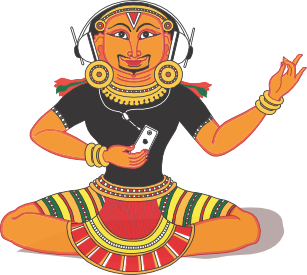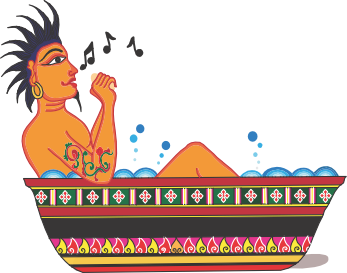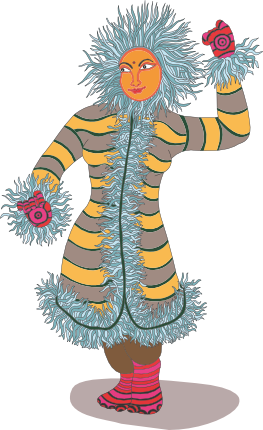Posted by admin in Music
on Aug 30th, 2011 | 0 comments
Ragas of the Morning
by
Tarun Jasani
“One who sings knowing the proper time remains happy. By singing ragas at the wrong time one ill-treats them. Listening to them, one becomes impoverished and sees the length of one’s life reduced.”
(Sangita-makaranda, I, 23-24)
If the true meaning of self-knowledge implies a state of enquiry into the Self that is not guided by the will, then Nature’s call to prayer is the activity mankind takes for granted – sleep. When the Sun fades and all extroversion, entertainment, and distraction is denied to Man, the mind retreats into a state of meditative introversion we call sleep. Thoughts that are unfinished in the mind, during the day, continue throughout the night in the forms of dreams, striving towards their resolution, as part of the brain’s intrinsic mechanism to find order. In a sense then, sleep is Nature’s way of reuniting Man with him or herself, enabling that which lies dormant in the hidden recesses of the mind, to reveal and express itself in secure isolation from the world. The dawn of a morning then, has tremendous significance. It is the first witness of the conscious mind to the revelations of the night. To many, the waking hours may express the calm satisfaction of a release, the relief of a burden, and a feeling of pious quietude. To others, however, the meditation of sleep may have brought to the surface of the mind, the most secret burdens of one’s life, and leave one in emotional turmoil. Therefore, if one were to provide a general description of the mood of a morning, perhaps it would be one of serenity and depth, holy, while simultaneously tinged with emotions ranging from great disturbance to supreme calmness.
The rich diversity of life-forms that inhabit the world have one key to their survival through the ages – interdependence. Each component of the Natural world lives its limited period in world, fulfilling its own role and purpose. The purpose of the Sun is to give light, the purpose of a flower, to bloom, and the breeze, to travel the Earth. Yet, without the Sun’s rays, the flower would not bloom, and without the breeze, its pollen would not spread. Therefore, each life-form indirectly fulfils the purpose of the other, through mutual interdependence, its short life playing only a humble yet significant role in Nature’s greater Order.
There is perhaps no greater myth than Mankind’s self-created illusion of his own individuality, as separate from Nature. The word “individual” originates from the word “indivisible”, meaning unfragmented, whole, complete in itself. Yet, Mankind treads on life’s soils confident in his own power of influence, and ignorant of his fundamental subservience to the influences of Natural forces.
Ancient civilisations however, understood the extent to which Man is influenced by Nature, and thus strove to act in harmony with it, through intimate understanding of its moods and workings. The concept of Pranic energy in Hindu thought, or Qi in Chinese philosophy, is central to understanding the various associations that exist, between human emotions on one side, and sound, colour, and the time of day on the other.
The theory is centred around the fundamental assumption that there exists a universal, unquenchable life-force in all things, the intensity of which varies in time, geographically, emotionally, from person to person, as well as internally, between the various energy point or chakras . The nine emotions can also be defined in terms of the intensity of Pranic energy, where, for example, depression and sorrow is associated with low or weak Prana/Qi and joy and happiness is associated with a high or strong level of Prana/Qi . On a larger scale, the planetary movements, the levels of the tides, the progression of the seasons and the on-going cycles of days and nights, are all explicable in terms of shifts in the levels ofPrana/Qi .
As no aspect of life can be divorced from the Pranic theory, it is only logical that all aspects of life are actually inter-connected and interdependent. Thus, a musical note has its own distinct psychological effect or emotion, and is also related specifically to a colour, mood, chakra, and time of day. All Sanskrit treatises on music have to some extent or other discussed this network of relationships. Thus, for example, the note Pa is associated with the emotions of love and laughter, and is also associated with dark colours. Therefore, according to the theory, ragas in which the note Pa is particularly strong, have in their emotional content, the emotions of love and the emotions associated with laughter. A ragamala painting expressing this raga, would also predominate with darker colours. This note is also associated with the deity Krishna, and so, he may be the subject of the painting. It may also be the case that a combination of notes, collectively express particular sentiments or moods. Consider the two notes Ma (shuddha) and ma (tivra) , the natural and augmented fourth. It is perhaps the close proximity of these two notes to each other, as well as their position at the mid-point of the scale, which make them expressive of crucial moments or precise moments of transition. Such moments include the sunrise, sunset, midday, and midnight, during the period of a day, and solstices and equinoxes during the period of a year. To give examples, consider the ragasLalit and Ramkali , both of which contain shuddha and tivra Ma and are played/sung at daybreak.
The historical musicologist, Vishnu Narayan Bhatkhande, in his attempt to organise and neatly categorise the various components of North Indian Classical Music, listed a series of characteristics which collectively distinguished a morning raga from an afternoon or evening raga . His first observation stated that those ragaswhich contained the notes Re, Dha , and Ga , were to be played between 7-10 o’clock in the morning or the evening. Secondly, those ragas which contained the notes re (flat), Ga , and Ni, came under the time period of sandhiprakas or twilight, and were to be played at either 4-7 o’clock in the morning or the evening.
Thirdly, those ragas which contained the notes ga (flat) and ni (flat) were to be played before sunrise or sunset, between 10-4 o’clock am. or pm. This category included the exception of the Tori family or That, which contains ragas with the notes Ga and Ni . The final factor, which ultimately determined whether the raga was to be played in the morning or the evening, was the position of the vadi (the most important or pivotal note of the raga ). If the vadi of a raga was in the lower tetrachord or purvanga, that is, between Sa-Ma or Sa-Pa, then the raga was to be played between the hours of 12pm-12am. Similarly, if the vadi of the raga was in the upper tetrachord or uttaranga , then the raga was to be played between the hours of 12am-12pm. Thus, for example, consider the raga Bhairav . The notes played in this raga are Sa re (flat) Ga Ma Pa dha (flat) Ni Sa. Because the raga contains the notes re (flat), Ga, and Ni , it satisfies the requirements for Bhatkhande’s second category, and is classified as a sandhiprakas raga, played during the period of twilight. Secondly, the vadi of this raga is the note dha (flat) . As this note is in the upper tetrachord of the scale, the raga is then classified as a morning raga. Therefore, raga Bhairav is played at daybreak.
The fundamental problem with the entire time theory of ragas is that few people are sensitive enough to feel the appropriateness of ragas played at their designated times. Instead, one is left accepting the words of the various scriptures, and the question remains whether one is better left to rediscover first-hand the relationship between the ragas and the time of the day, rather than resort to conformity.




